Top left: View of central Positano, early evening.
Top right: Fresco in the Roman Villa d'Ozio, under the church in Positano.
Bottom left: A pizza at Sal de Riso (Minori) with lemons.
Bottom right: A lemon orchard above Minori, Agricola Ruocco.
Getting There
Positano sits on the south coast of the Sorrento Peninsula, a long finger jutting out into the Tyrrhenian Sea and pointing at the island of Capri, a short boat ride away. The Lattari Mountains form the backbone of the peninsula running east west. Sorrento lies on the north side of the backbone and the Amalfi Coast and Positano on the south side.
During our time on the peninsula, the Lattari Mountains are always looming nearby providing a scenic backdrop. The mountains derive their name from the milk from goats that graze the upland pastures. Latteria in Italian is a dairy, so the name is easy to remember. One evening in Positano, we taste provolone del monaco, a cow's milk cheese also from the Lattari Mountains. The story of this cheese is that the shepherds that produce it once lived in Naples and urban expansion around 1700 forced them to seek better pastures on the Sorrento Peninsula.
You can approach Positano from Sorrento to the west or Salerno to the east. Whichever direction you choose, the drive requires a steady hand at the wheel and a good deal of neck craning to see what may be coming at you around blind corners.
On the peninsula, we wind along the north coast road until just before Piano di Sorrento (the plain of Sorrento) where we take a detour for lunch and descend from the cliffs to the beach at the town of Meta. Our lunch spot is Ristorante La Conca. We picked the restaurant from our slow food bible, the Osteria d'Italia guide.
Fueled by the delicious lunch, we resume our drive to Positano. Back on the Piano di Sorrento, we pass lemon orchards in walled gardens as we slowly gain altitude. Before we know it, we pass over to the south side of the peninsula at the town of San Pietro. We are on the Amalfi Coast.
After crossing over at San Pietro to the Amalfi Coast, we follow the road nicknamed the Via Nastro Azzurro, or if you like: Panoramica Statale 163. In English, Via Nastro aAzurro translates approximately as "blue ribbon road", which doesn't have quite the same ring to it does in Italian. On the road, we are driving between land and sea. Half of our view is brown and green Mediterranean macchia and the other half azure of the Mediterranean Sea. To be precise, the blue sea is the Gulf of Salerno, which is a gulf in the Tyrrhenian Sea, which in turn is part of the Mediterranean Sea. But the geographical details are not relevant to enjoying the dreamy blue.
In under 20 minutes, our cliff and sea view reveries are interrupted with lines of parked cars on the side of the road. We are approaching Positano. The cars are those who prefer free parking far out from the city center and hoofing it rather then paying for in-city parking. A few moments later, we are threading through cliffs and houses. Welcome to Positano.
In Positano
Positano is a collection of pastel-colored buildings draped on the hillside. Some buildings crouch under cliffs hiding, others perch on top of them flaunting. Many of the buildings are stacked offset from their neighbors above and below them, resembling a big stairstep from mountain to sea. Space is tight. No space is wasted.
It's helpful to think of Positano in two ways: horizontally and vertically. Horizontally, the coastline is not a straight affair. Instead, the land folds in and out on itself creating shady canyons and sun-drenched promontories, like ruffles of fabric. Thankfully, our vacation rental (Casa Marina) is one one of the sun-drenched promontories.
Also, thinking of Positano, banish the idea of a long sandy beaches. Think instead of mostly inaccessible (at least by foot) coastline with two moderately sized beaches, Fornillo Spiaggia and Positano Spiaggia, connected by a trail.
If you are on that trail, a stop a Lo Guarracino restaurant is worth it. We had a great lunch there. Try the scialatielli Guarracino, a seafood pasta (frutti di mare, calamari e gamberi). Scialatielli is a type of fresh pasta commonly served in the Campania region and in particular on the Amalfi Coast. It resembles an irregularly cut, curvy tagliatelle.
The name of the restaurant comes from lo guarracino and is the title of a celebrated Neapolitan song (one version) that tells of love and strife between fish. Lo guarracino is the damselfish, Chromis chromis. Note that it's "lo" instead of "il" as the definite article because it's the Neapolitan dialect.
The second key when thinking about the layout of Positano, is its verticalness. In fact, Positano feels more vertical than horizontal. Only visiting in person can you understand this statement. You have to feel it, or more precisely, your legs have to feel it climbing and descending the stairways that you invariably must to get anywhere.
Positano is one of those curious Italian towns (like Taormina) with one major one-way street, Via Pasitea, that snakes through it. This requires attention to where you are going when driving, or you'll find yourself making a 20-minute loop to reach something just a dozen feet behind you that you missed the first time.
Speaking of driving, it's better off to not drive in Positano when lodging there. Walk or take the bus. The bus plies the same major-one street twice an hour.
We mostly left our car parked except for arriving and departing and a one day trip to Minori and Ravello. We parked the car in a garage at 30 euros a night. We justified the expense of parking as part of the price of the vacation. (We were told we couldn't park overnight on the street, or we'd run the risk of a fine.) The garage we used was close to our accommodation on a large loping curve of Via Pasitea where three garages, side-by-side (approximately here), are in fierce competition. Ask your hotel or accommodation to recommend a garage close to where you are staying and ask to fix a price for per day parking before entering the lot.
It's March during our visit and the town is busy, but not with tourists, which are few, but with the town itself preparing for Easter and the start of the tourist season. As we drive the snaking Via Pasitea through the town, we dodge knots of locals talking, motor scooters, double-parked cars, trucks, and donkeys loaded with building materials waiting to trudge up to an unseen building under construction.
A few days before coming to Positano, we spent a full day at Pompeii and Herculaneum learning about the demise of the cities in the 79 A.D. eruption of Vesuvius. On the Amalfi Coast, that all feels far away even if it's only 20 km as the crow flies. We were surprised to learn that under the beautifully tiled church of Positano lies a roman villa that was buried by that very same eruption.
In 79 A.D. Vesuvius spewed a column of gas and ash up to 20 km in the air that winds brought south. The pumice and ash fell on the hills above Positano. However, the material didn't stay put and slid down the hill to fill the Positano bay and cover the villa up to 20 meters in volcanic material. Only the triclinium (dining room) of the villa is partly uncovered, but it's gorgeous in bright red, green, and blue colors. The villa is called Villa d'Ozio or "Leisure Villa" and it can be visited.
We were last in Positano in December 2000. During this trip, we find Positano just as magical as we did 22 years ago. Steinbeck wrote in 1953 that "Positano bites deep. It is a dream place that isn’t quite real when you are there and becomes beckoningly real after you have gone." We agree.
Itinerary
Our approximate itinerary for four-night stay in Positano is below. It's deliberately laid-back. We enjoyed spending time in the morning on our terrace mulling over breakfast and staring at the sea. We tended to head out each day, late morning. We'd say that was a perfect rhythm.
Friday
- Arrive in afternoon, settle in.
- Get groceries at the friendly supermarket Alimentari Di Giovanni De Lucia.
- Walk down to the main beach for a pleasant dinner at Le Tre Sorrelle 1953. Tip: be very clear with the price of any fish you buy fresh as to its price per kilo.
- Explore Positano and its vertical streets, aka staircases.
- Make our way to the main beach, exploring different ways of getting there.
- Lunch at Ristorante Bruno overlooking the coast.
- Stop at Buca di Bacco for sweets.
- Visit the museum time MAR Positano Villa Romana
- Shopping time along Via Pasitea, with a special nod to Rino Boutique.
- A day trip to Minori and Ravello.
- Second breakfast at Pasticceria Sal de Riso and later lunch there.
- Sal de Riso is the home of the dessert delizia al limone. We were a little skeptical about all the hype we'd heard about Sal de Riso as to how good it would be. Well, the desserts we tried looked beautiful and tasted good. We were so impressed after a mid-morning stop there to try it out that we returned for lunch and were equally impressed at the quality.
- The delizia al limone became the one desert we tried to order everywhere we went to try and find the best. Sal de Riso really did have the best to our taste. (He invented it.)
- Walk part of the Sentiero dei Limoni (Lemon Trail), that goes between Minori and Maiori.
- Visit Agricola Ruoccos along the sentiero, sample a raw lemon salad (yes, you heard that right), view a working lemon farm/grove, and learn a little about the Amalfitano Lemon, also called sfusato Amalfitano.
- Back to exploring of Positano
- Explore Fornillo Spiaggia (beach)
- Lunch at Lo Guarrancino
- Walk to the main beach
- Our third stop at Buca di Bacco for sweets.
- Dinner at Il Grottino Azzurro
- Leave early morning, back to Naples
Also, see the related post 60 Doors of Positano Italy – The Dérive (Drift).
Photos: Positano


Left: Panorama from Casa Marina, Positano.
Right: A cat sits in a window in Positano.
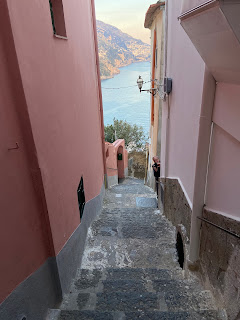

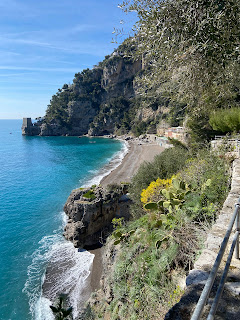
Left: Stairs in Positano with view of the Mediterranean Sea.
Center: A statue of the American Reverend Charles Thomas Underwood, in a park in Positano.
Right: View of Fornillo Beach, Positano.
Right: A frescoed ceiling detail in Casa Marina, Positano.


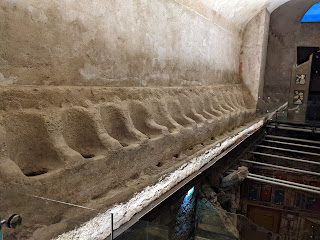
Desiccation chairs at the MAR Villa Romana Museum (Positano).
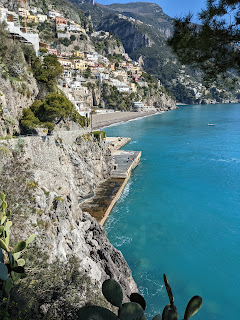


Left: View along Via Positanesi d'America toward the main Positano beach.
Right: The sign marking one end of the path Via Positanesi d'America.
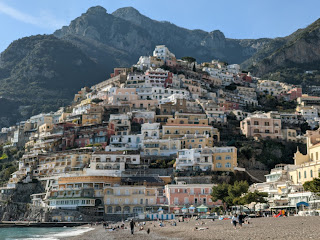


Left: View of Positano from the main beach.
Center: View of the eastern part of Positano.
Right: View of the western part of Positano.

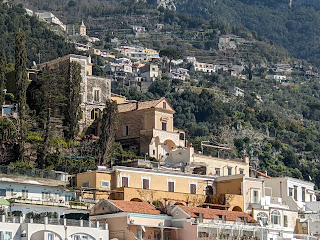

Left: View east over Positano.
Center: Positano stacked villas and hotels.
Right: Looking west from Positano's man beach with successive cliffs ending in the sea.

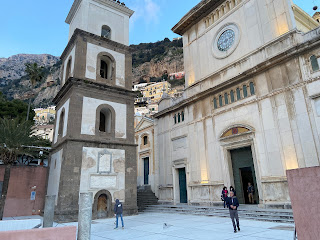

Left: View of Positano at dusk from the main beach.
Center: Positano's main church, Chiesa di Santa Maria Assunta.



Left: View west at dusk from Praiano with Positano visible.
Center: View west mid morning from Praiano with Positano visible.
Right: View from Positano toward the three islands known as Li Galli.
Photos: Minori
Left and center: View of the Sentiero dei Limoni, between Minori and Maiori, Amalfi Coast.
Right: View from the Sentiero dei Limoni toward Maiori.
Left: A sign indicating the Sentiero dei Limoni viewpoint.
Center: View of terraced hills with lemon orchards, view east toward Maiori.
Right: View of Minori from the Sentiero dei Limoni.
Lemon orchards on the Amalfi Coast between Minori and Maiori covered with black netting to protect them from hail.

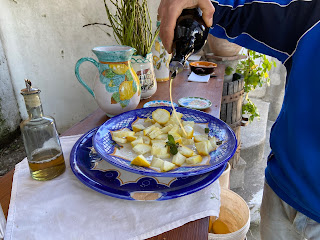

Center: Fresh lemon salad - Agricola Ruocco, Minori.
Left: A lemon salad made with Amalfi lemons from the orchard. Lemons, olive oil, salt.
Photos: Ravello
Left: Villa Rufolo - Hall of the Knights with palms - Ravello.
Center: View of Amalfi Coast from Villa Rufolo, Ravello.
Right: Statue group in the basilica of Ravello - La Basilica di Santa Maria Assunta e San Pantaleone.
Photos: Food
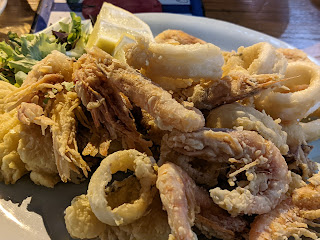
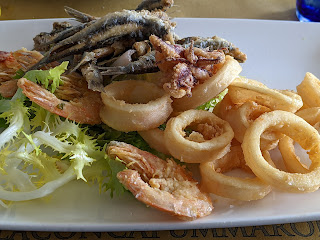

Left: Frittura mista - Il Grottino Azzurro (Positano).
Center: Frittura mista - Ristorante La Conca (Meta).
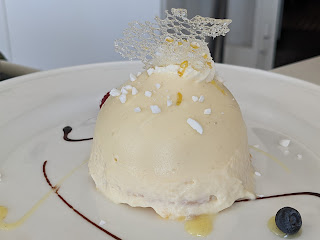


Left: Delizia al limone - Sal de Riso (Minori).
Center: Delizia al limone - Ristorante La Conca (Meta).
Right: Delizia al limone - Lo Guarracino (Positano).


Left: Spaghetti con alici di Cetara, broccoli e pane saporito - Ristorante La Conca (Meta).
Right: Scialatielli Guarracino - Lo Guarracino (Positano).



Left: Spaghetti con alici - Ristorante Bruno (Positano).
Center: Gnocchi alla Sorrentina - Ristorante Bruno (Positano).


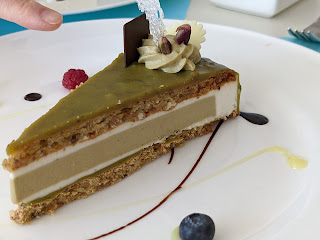
Left: Torta Caffè Fondente - Sal de Riso (Minori).

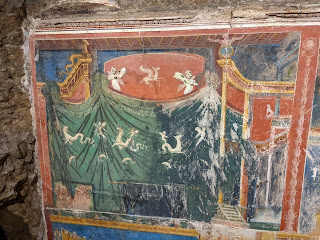
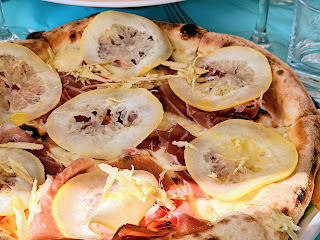
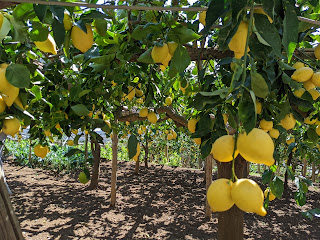
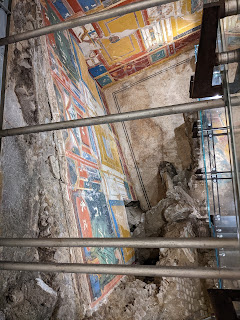




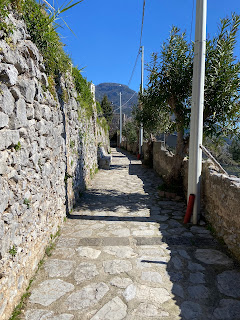
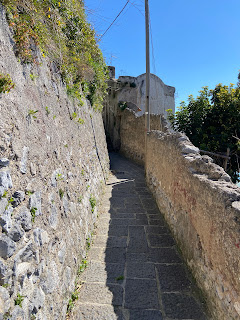
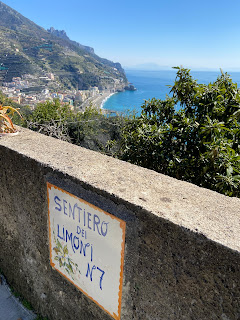


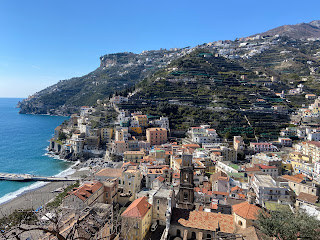

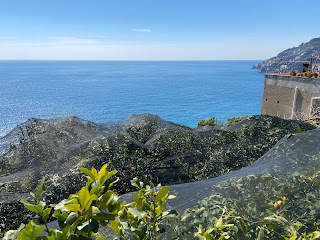
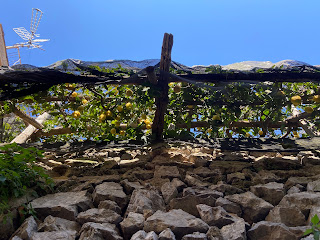
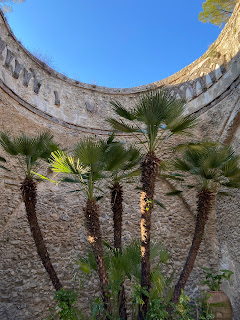

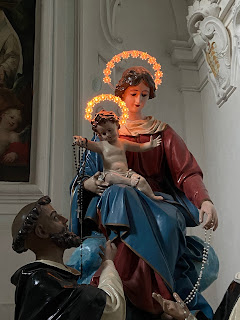
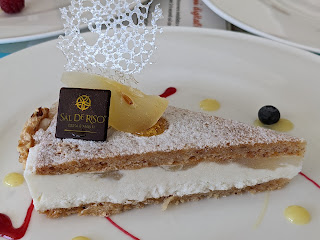
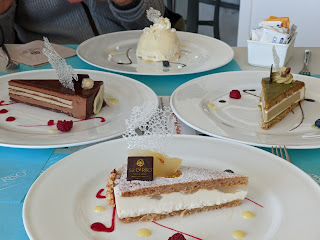

No comments:
Post a Comment
All comments are moderated. If your comment doesn't appear right away, it was likely accepted. Check back in a day if you asked a question.